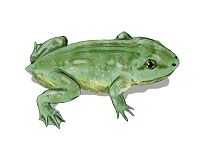Salientia
| Salientia Temporal range: Early Triassic - Holocene, 250–0Ma | |
|---|---|
 | |
| Life restoration of Triadobatrachus massinoti | |
| Scientific classification | |
| Kingdom: | Animalia |
| Phylum: | Chordata |
| Class: | Amphibia |
| Superorder: | Batrachia |
| Clade: | Salientia Laurenti, 1768 |
| Subgroups | |
Salientia (Latin salere (salio), "to jump") is a total group of amphibians that includes the order Anura, the frogs and toads, and various extinct proto-frogs that are more closely related to the frogs than they are to order Caudata, the salamanders and newts.[1]
Characteristics
Very few fossils of early salientians have been found, which makes it difficult to define the characteristics of the group and their taxonomic relationships. The arrangement of pectoral elements and the number of vertebrae are some guide, but the degree of vertebral articulation and the arrangement of the bones in the leg have not been found to be reliable indicators. The early proto-frogs developed from temnospondylid ancestors in which some of the elements of their vertebrae remained separate. The structure of the salientian pelvis and hind limb was probably developed for swimming rather than jumping. From the structure of the vertebrae, the group appears not to be monophyletic. Evolution of salientians seems to have been rapid and radiative. The essential features of recent groupings seem to have been established during the Mesozoic or early Tertiary. The families Discoglossidae, Pipidae and Pelobatidae are ecologically isolated, the harlequin frogs, restricted to a neotropical range in Central and South America, and the Ranidae and Bufonidae probably radiated from tropical regions of Africa and Asia.[2]
Species
The earliest salientian yet discovered is Triadobatrachus massinoti, known from a single fossil specimen found in Madagascar. It dates back to the Early Triassic, about two hundred and fifty million years ago. It had many frog-like features but had fourteen pre-sacral vertebrae while modern frogs have nine or ten. Previous fossil amphibians had many more presacral vertebrae than this and Triadobatrachus massinoti provides a missing link between salamanders and frogs. Other characteristics that distinguish it from modern frogs include the possession of a short tail with unfused vertebrae, a separate radius and ulna in the forelimb, and separate tibia and fibula in the hindlimb. The features it shares with modern frogs include a forward-sloping ilium, the fusion of the frontal and parietal bones into a single structure known as the frontoparietal, and a lower jaw bone with no teeth.[3]
Czatkobatrachus is another proto-frog with some characteristics similar to Triadobatrachus. It is from the early Triassic in Poland and has a shortened vertebral column, reduced tail and elongated ilium.[4]
Another early proto-frog was Prosalirus bitis, several fossil specimens of which have been found in Arizona. It dates back to the Early Jurassic, one hundred and ninety million years ago. It has primitive features but has a urostyle and an elongated, forward-directed ilium in its pelvis. These adaptations made it better able to absorb the impact of landing after a jump.[5]
Dating back to a similar date is Vieraella herbsti, a single specimen of which has been found in Santa Cruz Province, Argentina. It had ten presacral vertebrae but is considered to be more basal than Notobatrachus and living frogs.
Several specimens of Notobatrachus degiustoi have been found in Patagonia, Argentina. They date back to the Middle Jurassic, one hundred and sixty million years ago. It is unclear whether it should be considered the first modern frog or whether it should be placed in a sister group to Anura.[6]
Phylogeny
| Amphibia |
| |||||||||||||||||||||
| |
Cladogram from Tree of Life Web Project.[7]
References
- ↑ David Cannatella (1995). "Salientia". Tree of Life Web Project. Retrieved 2012-08-14.
- ↑ Griffiths, I (1963). "The phylogeny of the Salientia". Biological Reviews 38 (2): 241–292. doi:10.1111/j.1469-185X.1963.tb00784.x.
- ↑ David Cannatella (1995). "Triadobatrachus massinoti". Tree of Life Web Project. Retrieved 2012-08-14.
- ↑ Evans, S.E.; Borsuk−Białynicka, M. (2009). "The Early Triassic stem−frog Czatkobatrachus from Poland" (PDF). Palaeontologica Polonica 65: 79–105.
- ↑ Shubin, Neil H.; Jenkins, Farish A. Jr (7 September 1995). "An Early Jurassic jumping frog". Nature 377 (6544): 49–52. doi:10.1038/377049a0.
- ↑ David Cannatella (1995). "Notobatrachus degiustoi". Tree of Life Web Project. Retrieved 2012-08-14.
- ↑ David Cannatella (2007). "Living amphibians". Tree of Life Web Project. Retrieved 2012-08-14.